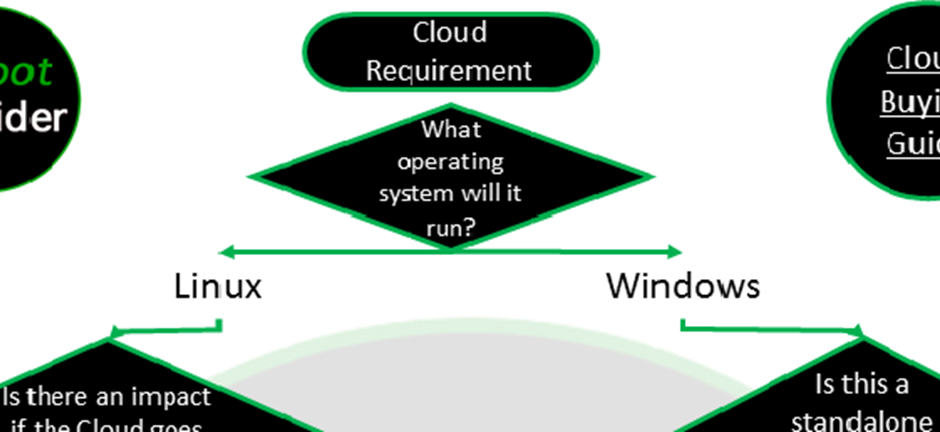
Hi Guys,
Over the past couple of months, I have had to really think about what is the Best Value Route for my clients, in terms of hosting. Naturally, to aid efficiency, you will always come up with ways to help you manage those thoughts and setup processes to cement into action.
Been wanting to write a more general buying guide for cloud for some time, as I can see plenty of articles on:
- What Cloud is
- What each provider can do
- Deep technical documents about components far beyond most
However, there are no articles on what to do when you wish to start the journey of outsourcing to the cloud. How should it be approached from a commercial perspective?
The below guide was an original benchmark I conducted to get a handle on the market, which I hope should prove useful or at least get you asking the right questions.
Notes around the below infographic
The main point of this exercise was to see, on a purely hour/hour rate, which of the main public cloud providers provided the lowest cost (not necessarily the best value – more later), between:
- Google Cloud Platform (GCP)
- Amazon Web Services (AWS)
- Microsoft Azure (Azure)
Infrastructure only, so no support (will cover in another article) and does not go into the technical USP’s of each, just the base cost – we all must start somewhere.
Base Example VM: 2vCPU, 4GB RAM and 100GB HDD.
I found the closest fit from each provider, demonstrated in the table below:

I then went through a decent proportion of the commercial documentation of each provider (only public information, as these, are also partners of mine) and compared over the entire set. This infographic will guide you through what questions to ask when you need a Virtual Machine (VM), in the mass cloud world:

As you can clearly see from the bottom results, the winner was AWS, purely by price point for 3/6 potential paths. Now, I have done research on much larger VMs and sets, with the tables turning dramatically, however, that too is for another post.
Let us dive into what drives the above, with each provider’s unique commercials:
Google Cloud
General
If you need, a Linux VM, of the above size or smaller, running over 16 hours per day, per month, GCP has the cheapest Linux base rate of all three. However, when faced with having to apply for a windows license, this is no longer the case.
Sustained use discounts (SUD)
After speaking with GCP, their main selling is SUD – basically the more you consume over a given month, the cheaper the base rate becomes. You are more than welcome to look at:
https://cloud.google.com/compute/pricing
For more detailed information, however, the basics are:
Use 100% Time = 30% Discount
Use 50% Time = 10% Discount (Viable case with 9-5 workings hours)
With variables, in between. So, for short terms projects, it works out a higher rate than others.
Preemptible VMs
GCP have employed an interesting tactic here, as for losing the guaranteed nature of a reserved VM (i.e. it can be turned off at ANY point by GCP for ANY reason) you get a rate that on the Linux side is, at an educated guess, is the lowest on the market. Useful for prototyping or (more sensibly) if you already have a VM tolerant architecture/code base.
https://cloud.google.com/preemptible-vms/
Amazon Web Services
General
If you need, a Windows VM, of the above size or smaller, AWS has the cheapest base rate of all three. Still find it hard to believe given the more than probable loss they must be making on the license, however, what the end business pays is our concern for this topic.
Upfront Reservation
An old concept, however, effective if it suits the needs. Essentially, for paying upfront for the year, both the Linux and Windows VM costs become the lowest on the market (technically £0.01 per hour more than Azure’s Standard VMs, however without restrictions)
https://aws.amazon.com/ec2/pricing/reserved-instances/
Microsoft Azure
General
Azure came out the bottom on all scenario tests, so from a cost perspective, only starts to work out when you look at the wider benefits of the system (another time).
“Basic” Tier VMS
Now this is where is gets interesting. If you are willing to forsake the more advanced features of cloud (specifically access to HA technologies like load balancers etc) then for a stable VM cost, they become the cheapest on the market.
More can be found here: https://azure.microsoft.com/en-gb/blog/basic-tier-virtual-machines-2/
Apologies for the age of the article, there seems to be a distinct lack of formal information on this tier.
Summary
Despite being the oldest horse in the race, from a purely cost-based perspective, AWS still holds the reigns, in terms of both short-term unrestricted use or long term stable.
Happy to discuss any of my findings in more detail, with a quick extract below:

Please bear in mind, that as part of the role of Root Provider, we are here to compare the whole market and find you the Best Value Route. In terms of VMs, you can save versus the “mass” cloud providers, if you choose a more traditional ISP!
As usual, please feel free to repost this, however, please give credit and link back to the source article.
Normal Blog Terms & Conditions Apply


